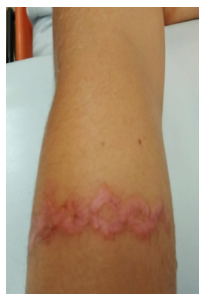Imaging cases
Dermatology clinical case
Caso clínico dermatológico
1 Department of Pediatrics, Hospital de Santa Luzia, Unidade Local de Saúde do Alto Minho. 4904-858 Viana do Castelo, Portugal. andreccazevedo@gmail.com; andreiacmarinhas@gmail.com; andrecostaesilva1@gmail.com; marianammcosta@hotmail.com; isabel.martinho@ulsam.min-saude.pt
Abstract
Herein are reported two cases of a previously healthy fourteen-year-old girl and a nine-year-old boy who presented to the Pediatric Emergency Department with a cutaneous reaction after applying a temporary black henna tattoo. Diagnosis of delayed hypersensitivity to black henna was established. Black henna tattoos are known for their temporary and harmless nature, but henna usually contains paraphenylendamine (PPD), originating black henna. PPD induces skin sensitization and causes allergic contact dermatitis.
Keywords: allergy; contact dermatitis; henna tattoo; rash
Resumo
São descritos dois casos clínicos correspondentes a uma rapariga de catorze e um rapaz de nove anos, previamente saudáveis, que recorreram ao Serviço de Urgência Pediátrica com uma reação cutânea após aplicação de uma tatuagem temporária de henna negra. Foi diagnosticada hipersensibilidade tardia à henna negra. As tatuagens de henna são conhecidas por serem temporárias e inofensivas, mas geralmente contêm parafenilenodiamina (PPD), obtendo-se dessa forma a henna negra. A PPD induz sensibilização da pele e causa dermatite de contato alérgica.
Palavras-chave: alergia; dermatite de contacto; exantema; tatuagem de henna
A previously healthy fourteen-year-old girl (Figure 1) and nine-year-old boy (Figure 2) presented to the Pediatric Emergency Department with a cutaneous reaction after applying a temporary black henna tattoo. Both cases had a history of acute eczematous reaction with pruritus on the arm, with blistering lesions in the girl. The rash appeared eight and ten days after the tattoo was applied, respectively, and followed its outline. The surrounding skin was erythematous and swollen. The remaining physical examination was unremarkable in both cases. Patients’ medical history was negative for atopic dermatitis or allergic reactions.
What is your diagnosis?
Diagnosis
Allergic contact dermatitis to black henna (delayed hypersensitivity)
Discussion
Black henna tattoos are frequently known for being temporary and harmless. Their use has recently increased, especially in children and teenagers.1 Henna alone is relatively safe but usually contains paraphenylenediamine (PPD), originating black henna.2 PPD is mainly present in hair dyes and black henna tattoos, intensifying the dark color and making the tattoo last longer.2 PPD may either be an irritant, directly damaging the skin, or an allergen, inducing skin sensitization and causing allergic contact dermatitis.2,4 Rash usually presents within 4-14 days through an acute eczematous reaction with erythema, severe itching, burning sensation, edema, and vesicular-bullous lesions.3 The reaction slowly resolves but can cause either hyperpigmentation/depigmentation, scarring, or keloid formation.1-3 Patients should be advised about future exposure to consumer products, such as hair dyes, or in the occupational setting. Patch testing with PPD can be performed to confirm the allergy.4,5 In general, black henna tattoos should be strongly discouraged, particularly if using dyes of unknown composition.5
Treatment and outcome
Both patients were prescribed an antihistaminic and started a five-day cycle with oral prednisolone. Rash improved, with inflammation resolution and no remaining scars or cutaneous pigmentation alterations.
Lessons from these clinical cases
Black henna tattoos can cause a delayed hypersensitivity reaction. Therefore, it is important to recognize rash characteristics and its usually benign outcome. Oral antihistamines and corticosteroids are effective and should be the first-line therapy. Henna tattooing should be avoided in the future.
References
1. Panfili E, Esposito S, Di Cara G. Temporary Black Henna Tattoos and Sensitization to paraphenylenediamine (PPD): Two Paediatric Case Reports and a Review of the Literature. Int J Environ Res Public Health. 2017; 14, 421. DOI: https://doi.org/10.3390/ijerph14040421.
[ Links ]
2. Redlick F, DeKoven J. Allergic contact dermatitis to paraphenylendiamine in hair dye after sensitization from black henna tattoos: a report of 6 cases. Canadian Medical Association Journal.2007; 176(4): 445-6. DOI: https://doi.org/10.1503/cmaj.061109.
[ Links ]
3. Calogiuri G, Di Leo E, Butani L, Pizzimenti S, Invorvaia C, Macchia L, et al. Hypersensitivity reactions due to black henna tattoos and their components: are the clinical pictures related to the immune pathomechanism? Clinical and Molecular Allergy. 2017; 15(1): 1-6. DOI: https://doi.org/10.1186/s12948-017-0063-6.
[ Links ]
4. Gawkrodger DJ, English JS. How safe is patch testing to PPD?. Br J Dermatol. 2006;154(6):1025-1027. DOI: https://doi.org/10.1111/j.1365-2133.2006.07275.x.
[ Links ]
5. Kind F, Hofmeir KS, Bircher AJ. Irritant contact Dermatitis From a Black Henna Tattoo Without Sensitization to Para-phenylendiamine. Pediatrics. 2013; 131(6): e1974-6. DOI: https://doi.org/10.1542/peds.2012-2938.
[ Links ]

















